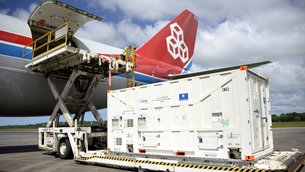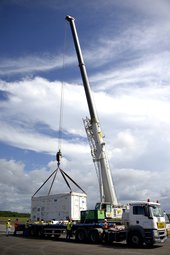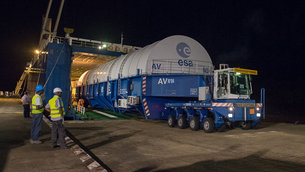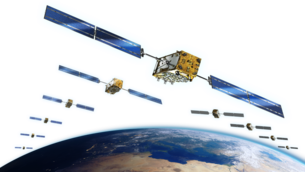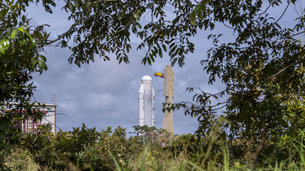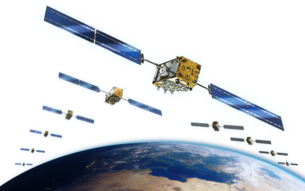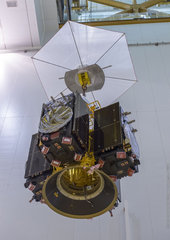22.05.2018
The initial two satellites for Ariane 5’s next Galileo launch begin processing in French Guiana

Two of the four Galileo satellites for Flight VA244 are shown inside the S1A payload preparation facility after being removed from their protective shipping containers.
-
Payload preparations have begun for Arianespace’s next Ariane 5 mission in support of Europe’s Galileo global navigation system, with two of the four satellites for launch on this July 2018 flight now undergoing their checkout at the Spaceport.
These two spacecraft arrived at French Guiana’s Félix Eboué Airport earlier this month aboard a 747 cargo jetliner, and were then unloaded and transported by road to the Spaceport’s S1A payload preparation facility. The third and fourth Galileo satellites will be delivered to the equatorial launch base in June.
Arianespace’s upcoming mission – designated Flight VA244 in the company’s launcher family numbering system – follows two previous Ariane 5 flights at the service of Galileo which delivered four satellites each to medium-Earth circular orbit in November 2016 and December 2017. Previously, Arianespace launched 14 Galileo spacecraft in pairs aboard medium-lift Soyuz vehicles.
Flight VA244 is to utilize an Ariane 5 ES version of the heavy-lift workhorse, equipped with a storable propellant upper stage. The vehicle will deploy its satellite passengers at a targeted orbit altitude of 23,222 km.
The civilian satellite navigation system for Europe
Galileo is Europe’s global civil satellite navigation system, providing positioning with great precision and reliability. The program is funded and owned by the European Union, with overall responsibility for management and implementation held by the European Commission.
Design and development of the new generation of systems and the technical development of infrastructure are entrusted to the European Space Agency, while the Galileo spacecraft are built by OHB System in Bremen, Germany, and the navigation payloads provided by Airbus-owned Surrey Satellite Technology in the United Kingdom.
Quelle: arianespace
---
Update: 5.06.2018
.
NEXT TWO GALILEOS PLUS LAUNCHER AT EUROPE’S SPACEPORT FOR JULY LAUNCH
Galileo satellites 25 and 26 have landed at Europe’s Spaceport in Kourou, French Guiana, joining their two predecessors ahead of their 25 July launch by Ariane 5.
The pair left Luxembourg Airport on a Boeing 747 cargo jet on the morning of 1 June, arriving at Cayenne – Félix Eboué Airport in French Guiana that evening.
They were unloaded, still in their protective air-conditioned containers, to be driven by truck to the cleanroom environment of the S1A payload preparation facility at Europe’s Spaceport. Here they joined Galileo satellites 23 and 24, which arrived last month.
The quartet will be launched together on a customised Ariane 5 on 25 July – designated Flight VA244 by Arianespace. The vehicle will deploy its satellite passengers at a targeted orbital altitude of 23 222 km.
The cryogenic main stage of this Ariane 5, known as the EPC – from its French title Etage Principal Cryogénique – arrived by sea at French Guiana’s Port Pariacabo on 30 May.
The Galileo System began Initial Services on 15 December 2016, and a growing number of commercial devices are using Galileo today. Completion of the constellation should improve Galileo’s positioning accuracy further still.
But Galileo satellites will continue to be launched into the future: a further 12 Galileo ‘Batch 3’ satellites were ordered last year, supplementing the 26 built so far to provide further in-orbit spares, and replacements for the oldest Galileo satellites, first launched in 2011.
A steady stream of orbital spares, ready to replace satellites reaching the end of their operational lives, is essential to ensure Galileo continues operating seamlessly.
Looking further ahead, with the aim of keeping Galileo services as a permanent part of the European and global landscape, new satellites will be required by the middle of the next decade, offering improved performance and added features.
About Galileo
Galileo is Europe’s own global satellite navigation system, consisting of both the satellites in space and their associated ground infrastructure.
The definition, development and in-orbit validation phases were carried out by ESA, and co-funded by ESA and the European Commission. This phase created a mini-constellation of four satellites and a reduced ground segment to validate the overall concept, ahead of further deployment.
Success led to the current Full Operational Capability phase, fully funded by the EU and managed by the European Commission. The European Commission and ESA have a delegation agreement by which ESA acts as system design authority and procurement agent on behalf of the European Commission.
Quelle: ESA
---
Update: 18.06.2018
.
All four satellites are undergoing preparation for Ariane 5’s next Galileo launch
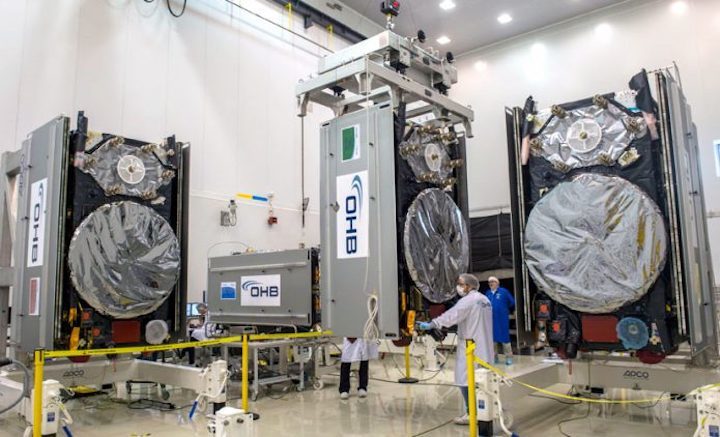
In the Spaceport’s S1A clean room facility, the four Galileo FOC satellites are prepared for their fit-check evaluation with the mission’s payload dispenser.
The four Galileo satellites for Arianespace’s next Ariane 5 mission at the service of Europe’s navigation system are coming together in their flight configuration, while parallel preparations continue with the mission’s heavy-lift launcher.
During pre-flight activity in French Guiana at the Spaceport’s S1A processing facility, these FOC (Full Operational Capability) spacecraft have undergone their fit-checks with the dispenser system to be installed on Ariane 5.
This dispenser system will secure the Galileo FOC satellites in place during their ascent to a targeted release altitude of 23,222 km., then deploy them in rapid sequence using a pyrotechnic separation system.
Designated as Flight VA244 in Arianespace’s numbering system, the July mission’s Ariane 5 is now at the Spaceport, positioning it for build-up in the Launcher Integration Building. After completion of verifications and systems checkout by production prime contractor ArianeGroup, this Ariane 5 ES version will be moved to the Spaceport’s Final Assembly Building for payload integration.
Galileo: Europe’s global navigation satellite system

As Europe’s own global navigation satellite system, Galileo is operated under civilian control, offering guaranteed high-precision positioning around the world. Its initial services began in December 2016, allowing users equipped with Galileo-enabled devices to combine Galileo and GPS data for better positioning accuracy.
The European GNSS Agency (GSA) is responsible for operating the Galileo satellite navigation systems on behalf of the European Union. Galileo spacecraft are built by OHB System in Bremen, Germany, and the navigation payloads provided by Airbus-owned Surrey Satellite Technology in the United Kingdom.
Flight VA244 is Arianespace’s third Ariane 5 mission carrying European Galileo satellites, following previous launches in November 2016 and December 2017. Prior to that, the company orbited 14 of them on seven Soyuz missions performed between October 2011 and May 2016.
+++
The Ariane 5 for Arianespace’s next Galileo mission is at the Spaceport

The cryogenic main stage for Arianespace’s Flight VA244 is transported across the Spaceport after arriving in French Guiana.
Launch vehicle elements for Arianespace’s third Ariane 5 flight at the service of Europe’s Galileo global satellite navigation system, which is planned for July, have been delivered to the Spaceport.
These components, including the core cryogenic stage, arrived in French Guiana aboard one of two sea-going roll-on/roll-off ships that transport launcher hardware from Europe to the South American launch site for Arianespace’s family of launch vehicles.
The mission – designated Flight VA244 in Arianespace’s launcher family numbering system – will orbit four more Galileo FOC (Full Operational Capability) spacecraft, to be deployed into medium Earth orbit from a dispenser system on the Ariane 5 ES launcher version. Galileo is designed to provide a new European global satellite navigation system with precision positioning services under civilian control.
A launch for European institutional customers
As Europe’s own global navigation satellite system, Galileo is operated under civilian control, offering guaranteed high-precision positioning around the world. Its initial services began in December 2016, allowing users equipped with Galileo-enabled devices to combine Galileo and GPS data for better positioning accuracy.
The European GNSS Agency (GSA) is responsible for operating the Galileo satellite navigation systems on behalf of the European Union. This authority was transferred to GSA from the European Space Agency (ESA) in July 2017.
Galileo spacecraft are built by OHB System in Bremen, Germany, and the navigation payloads provided by Airbus-owned Surrey Satellite Technology in the United Kingdom. Flight VA244’s four passengers are located at the Spaceport, where they are undergoing their own pre-flight preparations. The satellites were delivered to French Guiana via cargo aircraft, then transported by road to the Spaceport.
Arianespace already has launched 22 Galileo spacecraft, with eight being orbited on two previous Ariane 5 missions (Flights VA233 and VA240 in November 2016 and December 2017, respectively), and the others lofted by seven medium-lift Soyuz vehicles carrying two satellites each. Ariane 5 is delivered to Arianespace by ArianeGroup as production prime contractor.
Quelle: arianespace
---
Update: 19.06.2018
.
Satellites and rocket readied for July 25 Galileo launch

Four more Galileo satellites will be launched on a customized Ariane 5 on July 25.
The next Arianespace rocket to orbit Galileo satellites has begun taking shape at the spaceport in French Guiana, reported Arianespace. Build-up of the heavy-lift vehicle is now underway inside the spaceport’s Launcher Integration Building.
Following the established assembly flow, the rocket build-up began with this week’s positioning of the launch vehicle’s central core cryogenic stage over one of two mobile launch tables used for Ariane 5.

Ariane 5’s cryogenic main stage is moved into position over the mobile launch table inside the Spaceport’s Launcher Integration Building. (Photo: Arianespace)
-
It was followed by integration of the two large solid propellant boosters — installed directly on the launch table and mated to the core stage — clearing the way for placement of the upper stage, topped off with the vehicle equipment bay.
Once the Ariane 5’s basic build-up is completed under the direction of production prime contractor ArianeGroup, it will be moved to the spaceport’s Final Assembly Building for installation of its four Galileo FOC (Full Operational Capability) satellite passengers, which are undergoing their own pre-flight preparations at the spaceport.
The Ariane 5 will deploy its satellite passengers at a targeted orbital altitude of 23,222 kilometers in circular medium Earth orbit. The launch is designated Flight VA244 by Arianespace.
Galileo satellites arrive
In early June, Galileo satellites 25 and 26 landed at Europe’s Spaceport in Kourou, French Guiana, joining their two predecessors, satellites 23 and 24, according to the European Space Agency (ESA).
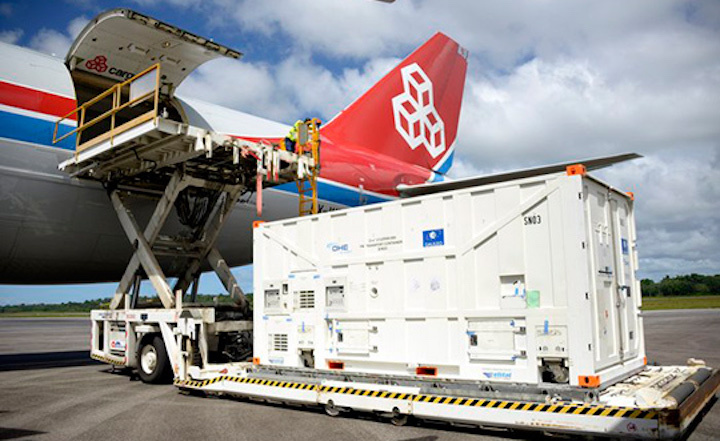
One of the two Galileo satellites 25 and 26 is unloaded from a Boeing 747 cargo jet at Cayenne – Félix Eboué Airport in French Guiana on June 1. The satellites travel inside protective air-conditioned containers. (Photo: ESA)
-
The pair left Luxembourg Airport on a Boeing 747 cargo jet on the morning of June 1, arriving at Cayenne – Félix Eboué Airport in French Guiana that evening.
After they were off-loaded, they were driven by truck to the cleanroom environment of the S1A payload preparation facility at Europe’s Spaceport, still in their protective air-conditioned containers. In the cleanroom, they joined Galileo satellites 23 and 24, which arrived last month.
The cryogenic main stage of the Ariane 5, known as the EPC — from its French title Etage Principal Cryogénique — arrived by sea at French Guiana’s Port Pariacabo on May 30.
A further 12 Galileo “Batch 3” satellites were ordered in 2017, supplementing the 26 built so far to provide further in-orbit spares and replacements for the oldest Galileo satellites, first launched in 2011.
A steady stream of orbital spares, ready to replace satellites reaching the end of their operational lives, is essential to ensure Galileo continues operating seamlessly, according to ESA.
Looking further ahead, with the aim of keeping Galileo services as a permanent part of the European and global landscape, new satellites will be required by the middle of the next decade, offering improved performance and added features.
Quelle: GPS World
---
Update: 5.07.2018
.
NEXT FOUR GALILEO SATELLITES FUELLED FOR LAUNCH

Europe’s next four Galileo satellites have been fuelled at Europe’s Spaceport in Kourou, French Guiana, in preparation for their launch on 25 July.
The four satellites were placed into their protective containers to be transported from the S1A processing building to the S3B payload preparation building, where they were filled with the hydrazine fuel that will keep the satellites manoeuverable during their 12-year working lives.
The next step is to fit the quartet onto the dispenser that holds them in place securely during launch and then releases them into space once the upper stage of the Ariane 5 rocket reaches its 22 922 km-altitude target orbit.
After that, the satellites plus dispenser will be fitted onto the upper stage then enclosed by the two sides of the protective launch fairing – one of which has had the mission logo added to it.
Meanwhile the Ariane 5 for this launch – known as Flight VA244 – has undergone assembly inside the Spaceport’s Launcher Integration Building.
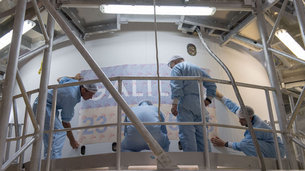
The Galileo System began Initial Services on 15 December 2016, and more than 100 million devices are using Galileo today.
About Galileo
Galileo is Europe’s own global satellite navigation system, consisting of both the satellites in space and their associated ground infrastructure.
The definition, development and in-orbit validation phases were carried out by ESA, and co-funded by ESA and the European Commission. This phase created a mini-constellation of four satellites and a reduced ground segment to validate the overall concept, ahead of further deployment.
Success led to the current Full Operational Capability phase, fully funded by the EU and managed by the European Commission. The European Commission and ESA have a delegation agreement by which ESA acts as system design authority and procurement agent on behalf of the European Commission.

EUROPE’S NEXT GALILEO SATELLITES IN PLACE ATOP ARIANE 5

Europe’s next Galileo satellites have been put in place on top of the Ariane 5 launcher due to lift them from Europe’s Spaceport in Kourou, French Guiana on Wednesday 25 July.
The launcher – appearing headless in the absence of its final payload – was moved from the BIL Launcher Integration Building, where it was assembled, to the BAF Final Assembly Building, ready for the Galileo satellites to be mated with it.
“In preparation for their launch the four satellites were switched off, apart from their battery charging line and another maintenance power line to their passive hydrogen maser – or PHM for short – atomic clocks,” reports Jean Verniolle, ESA’s Galileo mission director for this launch.
“Next Galileo satellites 23–26 were integrated one by one on four successive days onto the Galileo dispenser that will hold them securely in place for launch, and to form what we call the launch ‘stack’.”
On the evening of Tuesday 10 July, this integrated stack was transported to the BAF, then hoisted on top of the Ariane 5 the following day. The next step came on Thursday, when the protective launcher fairing – emblazoned with the Arianespace Flight VA244 logo – came down and enclosed the satellites, the last time they were glimpsed by human eyes.
The days that follow will see intensive activity on the launcher side. Meanwhile the dormant satellites will remain under temperature-controlled ventilation under the fairing, with their battery and PHM atomic clock maintenance lines being kept active and monitored continuously until launch.
The PHMs are the most precise atomic clocks ever flown for navigation, and keeping them powered on in advance of launch serves to maximise their reliability. Each Galileo satellite carries two PHMs plus two rubidium atomic clocks as backups.
“A formal launch dress rehearsal will be conducted on 18 July, one week before the launch,” adds Jean.
“Then on the following day we will hold a launch readiness review for the four Galileo satellites, followed by an Arianespace review of the launcher, the launch site and infrastructure, and the readiness of satellites and the launch and early orbit phase network, on 20 June, confirming a go for launch.”
The fully integrated Ariane 5 will be rolled out from the BAF to the launch pad on 23 July, scheduled to take around 1 hour 35 minutes.
The launch countdown will start around 2300 local time on Tuesday 24 July, with launch scheduled at 11:25 GMT (13:25 CEST, 08:25 local time) on Wednesday 25 July.
Upon separation of the satellites from the launch vehicle, the launch and early orbit (LEOP) phase will commence, whereby the satellites will be powered up and taken to their final orbital positions, upon which the in-orbit tests will be undertaken before the satellites will be declared operational.
This launch will mark Europe’s 99th Ariane 5 flight. The four new Galileo satellites will bring the constellation from 22 to 26 satellites in orbit.
The satellites are manufactured by OHB Systems (DE), with the launch undertaken by Arianespace (FR) both under contract to ESA. The LEOP is carried out by the Galileo operators SpaceOpal (DE, IT) together with CNES (FR) under responsibility of the GSA, the European GNSS Agency.
The Galileo System began Initial Services on 15 December 2016, and more than 100 million devices are using Galileo today.
About Galileo
Galileo is Europe’s own global satellite navigation system, consisting of both the satellites in space and their associated ground infrastructure.
The definition, development and in-orbit validation phases were carried out by ESA, and co-funded by ESA and the European Commission. This phase created a mini-constellation of four satellites and a reduced ground segment to validate the overall concept, ahead of further deployment.
Success led to the current Full Operational Capability phase, fully funded by the EU and managed by the European Commission. The European Commission and ESA have a delegation agreement by which ESA acts as system design authority and procurement agent on behalf of the European Commission.
Quelle: ESA
---
Update: 24.07.2018
.
ARIANE FLIGHT VA244
with four Galileo satellites

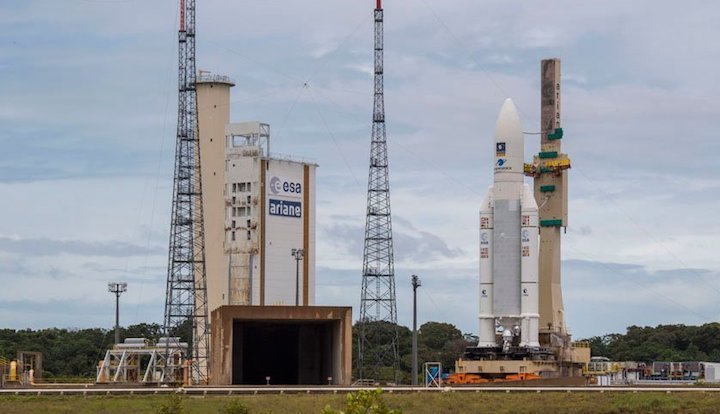
Ariane 5 reaches the launch zone for this week’s Arianespace mission with four Galileo satellites

The Ariane 5 for Arianespace Flight VA244 moves into the Spaceport’s ELA-3 launch complex in preparation for liftoff on Wednesday, July 25, with four Galileo satellites.
Arianespace’s next Ariane 5 for liftoff this year has rolled out to the launch zone in French Guiana, clearing the way for the heavy-lift vehicle’s third mission carrying satellites for Europe’s Galileo navigation system.
The completed Ariane 5 ES version was transferred today atop its mobile launch table from the Final Assembly Building – where payload integration occurred – to the Spaceport’s dedicated ELA-3 launch complex.
Designated Flight VA244 in the company’s numbering system, this upcoming Ariane 5 mission – set for Wednesday, July 25 – will lift off at exactly 8:25:01 a.m. local time in French Guiana and deploy its quartet of Galileo spacecraft into medium Earth orbit (MEO) on a nearly four-hour flight.
During the flight sequence, Ariane 5’s storable propellant upper stage will perform two burns, which are to be separated by a 3-hour, 8-minute ballistic phase. The four Galileo satellites have a liftoff mass of 717.7 kg. each, with Ariane 5’s overall payload lift performance set at 3,287 kg.
Another launch for European institutional customers
Flight VA244 is Arianespace’s third Ariane 5 mission carrying European Galileo satellites, following previous launches in December 2017 and November 2016. Prior to that, the company orbited 14 of them on seven Soyuz missions performed between October 2011 and May 2016.
As Europe’s own global navigation satellite system, Galileo is operated under civilian control, offering guaranteed high-precision positioning around the world. Its initial services began in December 2016, allowing users equipped with Galileo-enabled devices to combine Galileo and GPS data for better positioning accuracy.
The European GNSS Agency (GSA) is responsible for operating the Galileo satellite navigation systems on behalf of the European Union. Galileo spacecraft are built by OHB System in Bremen, Germany, and the navigation payloads provided by Airbus-owned Surrey Satellite Technology in the United Kingdom.
- A larger version of the photo above is available for downloading in the Gallery.
Liftoff time for Flight VA244:
| French Guiana | Universal Time (UTC) | Washington D.C., USA | Paris, France |
| 8:25:01 a.m. on July 25 |
11:25:01 on July 25 |
7:25:01 a.m. on July 25 |
1:25:01 p.m. on July 25 |
Quelle: arianespace
---
Update: 25.07.2018
,
WATCH THE LAUNCH OF GALILEOS 23–26
Watch live as Europe’s next four Galileo satellites are launched on an Ariane 5 launcher on Wednesday 25 July at 11:25 GMT (13:25 CEST, 08:25 local time) from Europe’s Spaceport in Kourou, French Guiana.
Galileo is Europe’s own global satellite navigation system, consisting of both the satellites in space and their associated ground infrastructure. These latest four Galileo satellites will bring the constellation in orbit up to 26 satellites.
Livestream coverage of the launch starts at 11:00 GMT (13:00 CEST) with liftoff at 11:25 GMT (13:25 CEST).
Live coverage resumes with confirmation of the satellites separating from their upper stage from 14:50 GMT (16:50 CEST).
Separation of the Ariane 5’s upper stage occurs about nine minutes after liftoff, followed by the first 10-minute firing of the upper stage.
The upper stage – carrying four 715-kg Galileo satellites – flies in ballistic configuration for three hours and eight minutes, after which a second upper stage firing lasting just over six minutes will place it into circular separation orbit.
Once stabilised at 3h 36 min after liftoff, the Galileo dispenser will release the first two satellites, followed by the second pair 20 minutes later.
Quelle: ESA
+++






For its fourth launch of the year, Arianespace will orbit four more satellites (satellites 23 to 26) for the Galileo constellation. This mission is being performed on behalf of the European Commission under a contract with the European Space Agency (ESA).
For the third time, an Ariane 5 ES version will be used to orbit satellites in Europe’s own satellite navigation system; with all Galileo spacecraft having been launched to date by Arianespace. Ariane 6 will take over from 2020.
Arianespace is proud to mobilize its entire family of launch vehicles for the benefit of Europe’s ambitions and its independent access to space.



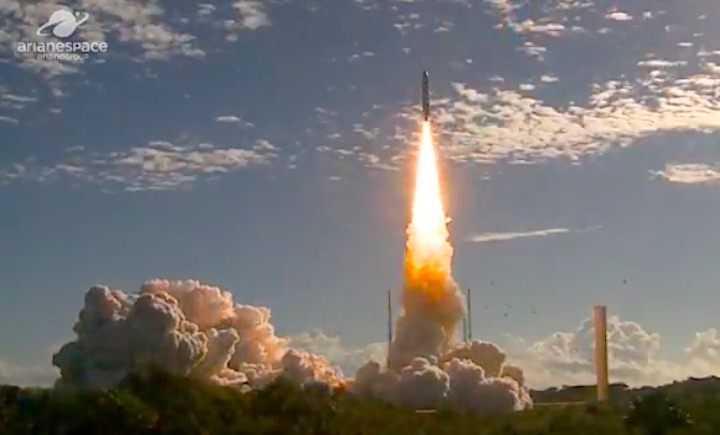

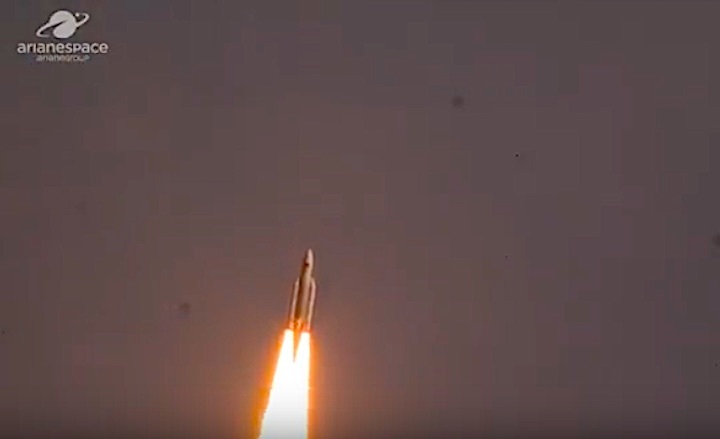

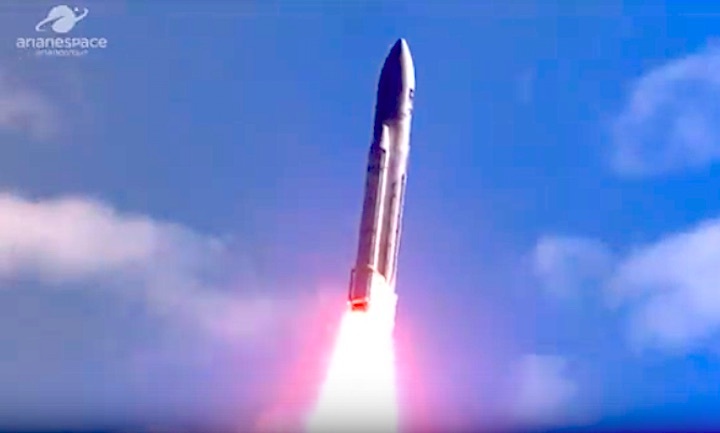


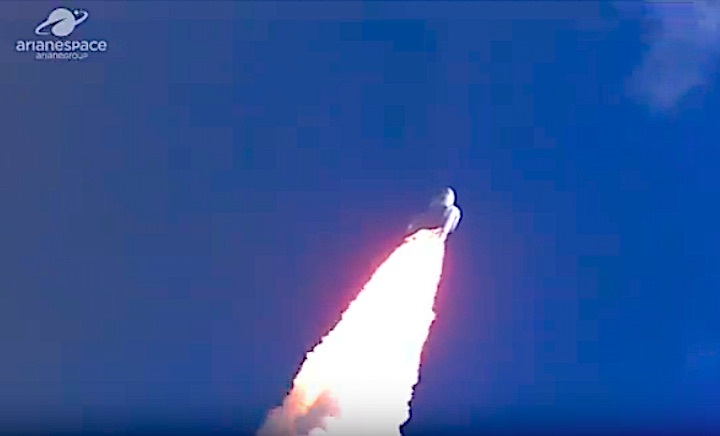
Quelle:arianespace

